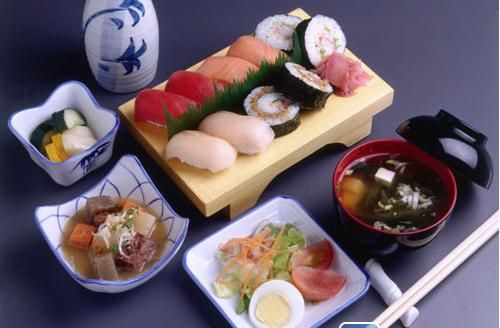本文目录
在中国有很多餐桌礼仪英语翻译
各国餐桌礼仪英语翻译
在法国,你完全可以用两只手吃饭——用刀叉或者是叉子加面包。面包在这里并不是开胃菜——而是帮助把食物弄到叉子上面的工具。吃面包的时候,慢慢的撕下,千万别直接对着面包咬。不用的.时候,面包是放在桌子或是桌布上的,别放在盘子里。以下是我为大家整理分享的各国餐桌礼仪英语翻译,欢迎阅读参考。

各国餐桌礼仪英语翻译
Dining Etiquette
Dining while abroad can feel as though you are tiptoeing around a minefield of unfamiliar rules. Table manners are the ultimate way to show respect (or some accidental disrespect) to your gracious host.
在国外吃饭,宛如蹑手蹑脚的游走在一堆不熟悉的规则中间。餐桌礼仪是对主人展现尊敬(有时反而显现不敬)的最好方式。
Slurp your food.
吃东西时砸吧嘴。
In Japan, most commonly when eating noodles and soups, slurping shows your appreciation of the food to the chef. The louder the better! You may also drink directly from the soup bowl -- spoons are uncommon. Furthermore, never cross your chopsticks, lick your chopsticks, or stick your chopsticks vertically into a bowl of rice. Its considered very rude in Japan and many other Asian countries, including China.
在日本,吃面喝汤极其寻常,发出啧啧声是对厨师食物的肯定。越大声越好!你还可以直接端起汤碗来喝汤——调羹反而用的不多。另外,千万别把筷子交叉,舔筷子或是把筷子垂直插在米饭中间。这在日本以及其他亚洲国家包括中国,都是极其粗鲁的表现。
Eat only with your right hand.
只用右手吃饭。
Sorry lefties -- in India, the Middle East, and some parts of Africa, it is considered unclean to eat with your left hand.
左撇子对不住啦——在印度、中东以及非洲某些地区,用左手吃饭是不卫生的表现。
Dont offer to split the bill.
别想着AA制。
In France, splitting the bill is considered the height of unsophistication. Offer to pay the bill in its entirety or someone else will.
在法国,AA制被看成不懂人情世故。要么就请客,不然就等别人买单吧。
Bread is a utensil.
面包只是食具。
In France, you are supposed to use two hands to eat -- either fork and knife or fork and bread. Bread isnt meant to be an appetizer -- instead it serves to assist the food to the fork. When you eat the bread, tear off a piece of it to eat instead of biting directly into the bread. When not in use, the bread belongs on the table or tablecloth instead of the plate.
在法国,你完全可以用两只手吃饭——用刀叉或者是叉子加面包。面包在这里并不是开胃菜——而是帮助把食物弄到叉子上面的工具。吃面包的时候,慢慢的撕下,千万别直接对着面包咬。不用的时候,面包是放在桌子或是桌布上的,别放在盘子里。
Dont touch any part of your meal with your hands.
不要用手碰到任何食物。
In Chile, touching food with your hands is considered ill-mannered. Yep, even fries! In Brazil, too, pizza and burgers are normally eaten with a fork and knife.
在智利,用手碰食物是非常不礼貌的表现。是的,甚至是薯条!而在巴西亦是如此,披萨和汉堡通常都是用刀叉吃的。
Dont put food in your mouth with a fork.
不要用叉子把食物放在嘴里。
In Thailand, forks are used to push food into a spoon. Also, its unusual to use chopsticks -- theyre considered tacky.
在泰国,一般都是用调羹吃东西,用筷子都是很奇怪的——会被看成没有教养。
;各国餐桌礼仪英语作文
关于各国餐桌礼仪英语
每个国家在餐桌上都有哪些礼仪呢?下面由我为大家整理的各国餐桌礼仪英语,欢迎大家查看!

Britain
英国
Always: Eat with your fork in your left hand and knife in your right.
√左手持叉,右手持刀。
Never: Speak with your mouth full.
×说话时嘴里塞满了食物。
Denmark
丹麦
Always: Place your fork downwards on a plate if you want seconds.
√若要添菜,可将餐叉朝下,置于盘上。
Never: Take the last item on any given plate. You must continue to halve it until only crumbs are left.
×取走盘中最后一份食物。若盘中留下一人份时,可考虑分而食之。
Japan
日本
Always: Indulge in slurping. It is considered polite.
√吃饭大声咂吧,在日本被视为礼貌之举。
Never: Pour yourself a drink. It is tradition to pour drinks for one another.
×自己倒饮料。食客为彼此倒饮料,才符合传统习俗。
Thailand
泰国
Always: Consider meals as a social event where only the person perceived as the riches pays.
√饭局其实是个社交场合,最有钱的那个自然会买单。
Never: Leave your chopsticks in the bowl. It symbolises death.
×将筷子插在碗中,那很不吉利。
Mexico
墨西哥
Always: Wait for your host to say ‘Buen Provecho’ (Enjoy your meal) before eating.
√等主人说完“用餐愉快”(Buen Provecho)后,再开始吃喝。
Never: Arrive on time. Arrive 30 minutes late, if not later.
×准时赴宴。迟到30分钟以上,并不为过。
Middle East
中东
Always: Eat your meal in silence.
√用餐时保持安静。
Never: Pass food with your left hand.
×用左手递食物。
Germany
德国
Always: Cut as much food as possible with your fork to compliment the cook that the food is tender.
√取食时,能切多大切多大。在德国,这意在称赞厨师技艺高超,做出的料理入口即化。
Never: Cut lettuce in a salad. Fold it with a fork.
×吃沙拉时切生菜。食客不妨用餐叉叉起食用。
Mongolia
蒙古
Always: Keep your palm facing up when holding cups.
√持杯时,手掌朝上。
Never: Spill milk or dairy products. It is considered bad luck.
×将牛奶或乳制品洒在地上。蒙古人认为,这会带来厄运。
Kenya
肯尼亚
Always: Wash your hands before eating: a basin may be brought to the table for you.
√餐前洗手。餐桌上甚至备有洗手盆。
Never: Eat before the eldest male. He must eat first before anyone else can start.
×抢在最老的男性长辈前用餐。要知道,家中最老的'男性长辈享有优先用餐权。
Chile
智利
Always: Let the woman sit down before the men.
√邀请女士先入座。
Never: Speak with cutlery in your hands.
×手持刀叉,与他人交谈。
日本的餐桌礼仪文化英语作文
Go to the Japanese restaurant for dinner,take off the shoes in the box door,must face the box (can squat off),do not back to the box off.Take off shoes a U-turn to put.
General guests seated before,if the host invites you in advance,you have to be happy to accept,and bowed.
Don't use chopsticks:① lick chopsticks; ② fan chopsticks:chopsticks shilly-shally; the hand,move chopsticks:this dish move the dish move the chopsticks:chopsticks;torsion torsion; the chopsticks:in taking food,or inserted in the steamed rice; the cross chopsticks:chopsticks on the bowl on the cross.

各国的餐桌礼仪英语作文
各国的餐桌礼仪英语
每个国家都各有其餐桌上的礼仪,那么各国的餐桌英语礼仪是怎样的呢?下面由我为大家整理的各国的餐桌礼仪英语,希望可以帮到大家!

Dining while abroad can feel as though you are tiptoeing around a minefield of unfamiliar rules. Table manners are the ultimate way to show respect (or some accidental disrespect) to your gracious host.
在国外吃饭,宛如蹑手蹑脚的游走在一堆不熟悉的规则中间。餐桌礼仪是对主人展现尊敬(有时反而显现不敬)的最好方式。
Now it's time to learn how to eat. Here are some of the very specific dining do's and don't's from around the world.
现在就来学学如何吃饭吧。下面是全球一些餐桌礼仪,该做什么不该做什么。
Slurp
Slurp your food.
吃东西时砸吧嘴。
In Japan, most commonly when eating noodles and soups, slurping shows your appreciation of the food to the chef. The louder the better! You may also drink directly from the soup bowl -- spoons are uncommon. Furthermore, never cross your chopsticks, lick your chopsticks, or stick your chopsticks vertically into a bowl of rice. It's considered very rude in Japan and many other Asian countries, including China.
在日本,吃面喝汤极其寻常,发出啧啧声是对厨师食物的肯定。越大声越好!你还可以直接端起汤碗来喝汤——调羹反而用的不多。另外,千万别把筷子交叉,舔筷子或是把筷子垂直插在米饭中间。这在日本以及其他亚洲国家包括中国,都是极其粗鲁的表现,
right hand
Eat only with your right hand.
只用右手吃饭。
Sorry lefties -- in India, the Middle East, and some parts of Africa, it is considered unclean to eat with your left hand.
左撇子对不住啦——在印度、中东以及非洲某些地区,用左手吃饭是不卫生的表现。
split the bill
Don't offer to split the bill.
别想着AA制。
In France, splitting the bill is considered the height of unsophistication. Offer to pay the bill in its entirety or someone else will.
在法国,AA制被看成不懂人情世故。要么就请客,不然就等别人买单吧。
Bread
Bread is a utensil.
面包只是食具。
In France, you are supposed to use two hands to eat -- either fork and knife or fork and bread. Bread isn't meant to be an appetizer -- instead it serves to assist the food to the fork. When you eat the bread, tear off a piece of it to eat instead of biting directly into the bread. When not in use, the bread belongs on the table or tablecloth instead of the plate.
在法国,你完全可以用两只手吃饭——用刀叉或者是叉子加面包。面包在这里并不是开胃菜——而是帮助把食物弄到叉子上面的工具。吃面包的时候,慢慢的撕下,千万别直接对着面包咬。不用的时候,面包是放在桌子或是桌布上的,别放在盘子里。
hands
Eat with your hands.
用手吃饭。
In Mexico, it is considered an almost snobby practice to use a fork and knife.
在墨西哥,用刀叉吃饭是十分势利的`表现。
touch
Don't touch any part of your meal with your hands.
不要用手碰到任何食物。
In Chile, touching food with your hands is considered ill-mannered. Yep, even fries! In Brazil, too, pizza and burgers are normally eaten with a fork and knife.
在智利,用手碰食物是非常不礼貌的表现。是的,甚至是薯条!而在巴西亦是如此,披萨和汉堡通常都是用刀叉吃的。
cheese
Don't ask for cheese.
不要要芝士。
In Italy, never ask for cheese if it's not explicitly offered to you. It's considered a sin to put extra cheese on top of your pizza -- and it's even worse to put it on seafood.
在意大利,如果没有给你提供芝士,千万别去要。在披萨上放入多余的芝士会被看成是一个诅咒--如果放在海鲜上就更糟了。
salt and pepper
Don't ask for salt and pepper.
不要要盐或胡椒粉。
In Portugal, if salt and pepper aren't already on the table, don't ask for them. It's considered an offense to the chef's seasoning skills.
在葡萄牙,如果桌子上没有盐和胡椒粉,千万别要。这会被看成是对厨师调味技巧的挑衅。
fork
Don't put food in your mouth with a fork.
不要用叉子把食物放在嘴里。
In Thailand, forks are used to push food into a spoon. Also, it's unusual to use chopsticks -- they're considered tacky.
在泰国,一般都是用调羹吃东西,用筷子都是很奇怪的——会被看成没有教养。
belch
Be sure to belch and make a mess.
记得打嗝和让桌子乱糟糟的
In China, belches are considered an indication of your satisfaction and a compliment to the chef on a job well done. Making a mess around the table serves a similar purpose, and leaving a bit of food leftover shows your host that he or she has provided you with more than enough food.
在中国,打嗝可以体现你的满意,以及对厨艺的赞赏。桌子弄的乱糟糟也可以达到同样的效果,别忘了再剩一点食物,这样主人们就会知道给你们提供的食物够分量了。
yellow flowers
Don't bring yellow flowers to dinner.
不要带着黄花去吃饭。
In Bulgaria, yellow flowers symbolize hatred. Not the message (we hope) you're trying to send.
在保加利亚,黄花意味着仇恨。(我们希望)应该不是你想传达的信息。
lap
Never rest your hands in your lap while dining.
吃饭的时候别把手放在膝盖上。
In Russia, it is considered polite to rest your wrists on the edge of the table -- not on your lap. Also, keep your fork in your left hand and knife in your right.
在俄罗斯,把手放在桌子边搭着是礼貌的行为——但千万别放在膝盖上。另外叉子要在左边,刀要在右边。
individual plate
Don't use an individual plate.
不要自己用个盘子。
In Ethiopia, individual plates are considered wasteful. Food is always shared from a single plate without the use of cutlery -- just hands.
在埃塞俄比亚,每个人单独用个盘子被认为是相当浪费的。通常食物都是放在一个盘子里供大家分享,无需刀叉——手就够了。
;以上就是关于日本的餐桌礼仪英语 ,在中国有很多餐桌礼仪英语翻译的全部内容,以及日本的餐桌礼仪英语 的相关内容,希望能够帮到您。

